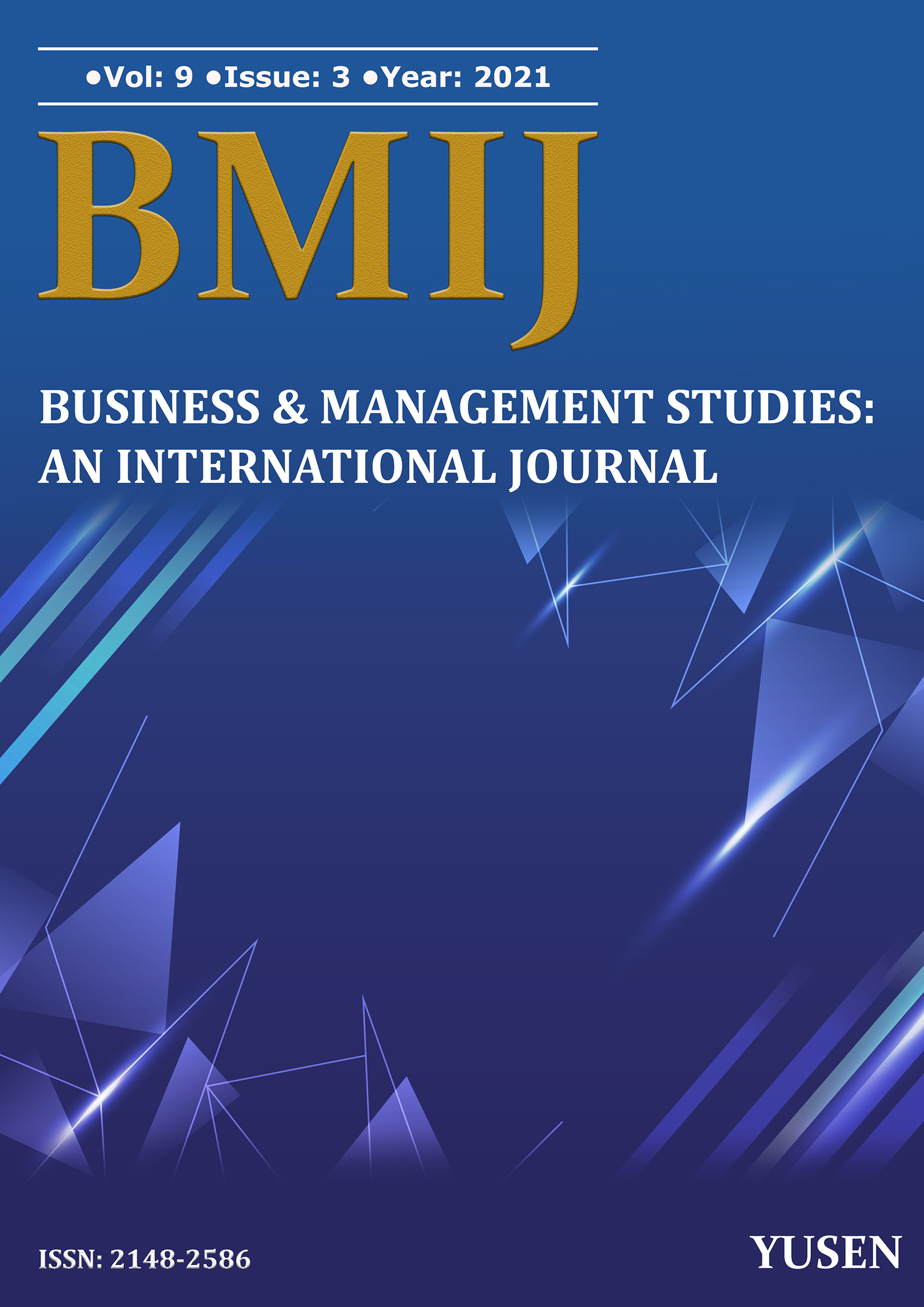Bibliometric analysis of research in the field of organizational communication in the web of science database

Published 2021-09-24
Keywords
- Örgüt,
- İletişim,
- Örgütsel İletişim,
- Bibliyometrik Analiz,
- VOSviewer
- Organization,
- Communication,
- Organizational Communication,
- Bibliometric Analysis,
- VOSviewer
How to Cite
Copyright (c) 2021 Abdullah Türk- Kağan Cenk Mızrak

This work is licensed under a Creative Commons Attribution-NonCommercial-NoDerivatives 4.0 International License.
Abstract
For organizations, communication is one of the most critical factors affecting their continuity, goals, and success levels. Organizational communication directs the relationship between internal and external stakeholders of the organization by taking a role in all organizational action and managerial processes. In this context, it also affects organizational outcomes. Effectively and efficiently channelling intra-organizational communication for organizational success is also effective in employees' understanding of their duties and responsibilities within the organization and activating their knowledge skills and abilities in line with the organisation's goals. At this point, it can be said that organizational communication adds mobility to businesses through self-expression. From this perspective, it understands the communication subject's development processes that play a crucial role for organizations in the literature and revealing its relationship with other variables will bring a systematic and holistic perspective to the relevant literature. With the bibliometric analysis method made for this purpose, it is aimed to create a perspective on how organizational communication offers mobility to businesses, the development, quality and quantity of the process. In this context; Distribution of studies on organizational communication by years, co-authorship of authors, co-authorship of organizations, co-authorship of countries, citation of authors, bibliographic coupling of documents, co-citation of authorship, co-citation of sources, co- The maps of occurrence of keywords were created, and the levels of contribution to the literature and the areas where the subject interacts were conveyed.
Downloads
References
- Ayeni, A. J., & Akinola, O. B. (2020). Organizational Communication and Teachers’ Productivity in Secondary Schools in Ondo State, Nigeria. Revista Journal of Education and Practice, 11(17), 94-102.
- Bakan, İ. ve Büyükbeşe, T. (2004). “Örgütsel İletişim ile İş Tatmini Unsurları Arasındaki İlişkiler: Akademik Örgütler için Bir Alan Araştırması”, Akdeniz İİBF Dergisi, 7, 1-30.
- Broadus R. N. (1987). Toward a Definition of “Bibliometrics”, Scientometrics, 12 (5-6): 373-379.
- Çakır, M. (2020). Örgütlerde iletişim sorunlarının saptanması ve çözümü için kullanılabilecek teknikler üzerine bir inceleme, İşletme Araştırmaları Dergisi, 12 (1), 973-989.
- Çetinkaya, F. F., & Akkoca, Y. Stratejik Liderlik İle Örgütsel Çeviklik Arasındaki İlişkide Örgütsel İletişimin Aracı Rolü. Mehmet Akif Ersoy Üniversitesi İktisadi ve İdari Bilimler Fakültesi Dergisi, 8(1), 66-84.
- Genç, N. (2004). Yönetim Organizasyon, Ankara: Seçkin Yayınları.
- Gökçe, O. (2006). İletişim Bilimine Giriş. Ankara: Siyasal Kitabevi.
- Kaplanseren, S., & Nart, S. (2020). Psikolojik Güçlendirme Ve Presenteeism İlişkisinde Örgütsel İletişimin Aracılık Etkisi: Y Kuşağı Çalışanlarına Yönelik Bir Araştırma. Journal of Administrative Sciences/Yonetim Bilimleri Dergisi, 18(38).
- Kasemodel, M. G. C., Makishi, F., Souza, R. C. ve Silva, V. L. (2016).“Following the trail of crumbs: A bibliometric study on consumer behavior in the Food Science and Technology field”, International Journal of Food Studies, 5(1):73-83
- Khara, B., Dey, J. K., & Mondal, S. K., (2020). Sustainable recycling in an imperfect production system with acceptance quality level dependent development cost and demand. Computers & Industrial Engineering, 142, 106300.
- Kılıçarslan, S. (2016). İletişime Giriş. Ankara: Seçkin Yayınları.
- Kristina, K. (2020). The Organizational Communication Perspective Theory. Journal of Social Science, 1(3), 61-74.
- Kurudayıoğlu, M. ve Deniz, K. (2001). İletişim. Ankara: Gazi Üniversitesi.
- Li, K., Rollins, J. ve Yan, E. (2018). Web of science use in published research and review papers 1997–2017: A selective, dynamic, cross-domain, content-based analysis. Scientometrics, 115, 1–20.
- Oğuzhan, M. (2020). Kamuda Örgütsel İletişim Sorunsalı: E-Devlet'e Kısa Bir Bakış.
- Okuba, Y. (1997), “Bibliometric Indicators and Analysis of Research Systems: Methods and Examples”, OECD Science, Technology and Industry Working Papers, 1997/01, OECD Publishing, (http://dx.doi.org/10.1787/208277770603).
- Omoregbe, O., Naseer, A., Steinberger, M. R., El-Kharouf, W. A. & H. Onyeaka. (2020). Carbon capture technologies for climate change mitigation: A bibliometric analysis of the scientific discourse during 1998–2018. Energy Reports. Volume 6, November 2020, Pages 1200-1212.
- Solmaz, B. (2004). Kurumsal Söylenti ve Dedikodu Türkiye'deki İşletmeler Üzerine Bir Uygulama. Konya: Tablet Kitapevi.
- Suh, J., Harrington, J., & Goodman, D. (2018). Understanding the link between organizational communication and innovation: An examination of public, nonprofit, and for-profit organizations in South Korea. Public Personnel Management, 47(2), 217-244.
- Tanrıverdi, H. & Adıgüzel, O. ve Çiftçi, M. (2010). “Sağlık Yöneticilerine Ait İletişim Becerilerinin Çalışan Performansına Etkileri: Kamu Hastanesi Örneği”. Süleyman Demirel Üniversitesi Sosyal Bilimler Enstitüsü Dergisi. Sayı:11, 101-122.
- Tatar, C.C. & Ece, A. S. (2012). Bilimsel Dergilerdeki Müzik Makalelerinin Bibliyometrik Profili. Akademik Bakış-Uluslararası Hakemli Sosyal Bilimler Dergisi, (30), 1-16.
- Tutar, H. & Yılmaz, M. K. (2013). İletişim Genel ve Örgütsel Boyutuyla. Ankara: Seçkin Yayıncılık.
- Van Raan, A. F. J. (2005). Fatal Attraction: Conceptual and Methodological Problems in the Ranking of Universities by Bibliometric Methods.Scientometrics, 62(1), 133-143.
- Yılmaz, B. (2003). “Toplumsal İletişim ve Kütüphane”, Hacettepe Üniversitesi Edebiyat Fakültesi Dergisi, 20(2), s.11-29.


